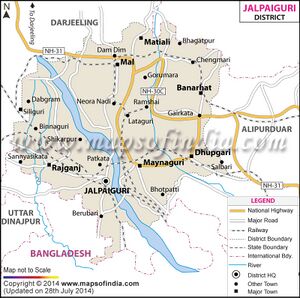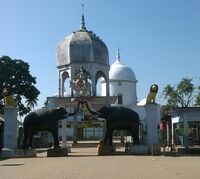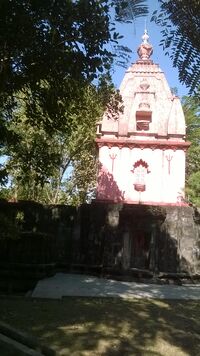Mainaguri
| Author:Laxman Burdak, IFS (R) |

Mainaguri (मयनागुड़ी) is a town and tahsil in the Jalpaiguri district in West Bengal, India. It is known as the "Gateway of the Dooars" and is a regionally significant tourist destination for "Jalpesh Temple" of Lord Shiva and nearby Gorumara National Park.
Variants
- Maynaguri (मयनागुड़ी)
Location
Mainaguri is located at 26.57°N 88.82°E. It has an average elevation of 84 metres (275 feet). Mainaguri is about 10 km north-east of Jalpaiguri and 50 km from Siliguri. The nearest airport is Civil Enclave Bagdogra, and the nearest railway station is New Mainaguri.
Jat clans
History
Local attractions
Local attractions include Jalpesh Temple, Gorumara National Park and Chapramari Wildlife Sanctuary.
Jalpesh Mandir, Maynaguri

Tej Ram Sharma [1] writes that the Nepala valley originally contained a lake called Naga Basa or Kalihrada, in which lived Naga Karkotaka. It was fourteen miles in length and four miles in breadth [2]
The former name of Nepala was Slesmatakavana. [3] The famous temple of Pasupatinatha on the western bank of the Bagmati River, is situated about three miles north west of Kathmandu in the town of Devipatan said to have been founded by Asoka's daughter Carumati. [4] The Saktisangama Tantra describes the country of Nepala as placed between Jaṭesvara and Yogini. [5] Sircar equates Yoginipura with Delhi and Jatesvara with Jalpesvara, the famous Siva of the Jalpaiguri district in North Bengal. [6]
Jalpesh Mandir is an old and famous temple of Lord Shiva, located at Jalpesh near Maynaguri of Jalpaiguri district of North Bengal. The Jalpesh Temple is approximately 3 kilometres from away Mainaguri. It is dedicated to Lord Jalpeshwar (Siva). During the month of July-August (Shravan), thousands of pilgrims come to Jalpesh Mandir to offer special puja to Lord Shiva. [7]
The temple is of historical significance since its first inception in 800 AD. The temple was first built by the successor of king Bhagadatta named Jalpesh. Temple was destructed by Bakhtiyar Khalji during his Kamarupa invasion. Later it was renovated by Basu Singh, the father of Koochbehar's king Maharaja Narayan in 1525 AD.[8]
Jatileswar Temple, Maynaguri

Jatileswar Mahadev Temple, Mainaguri, a Brick temples of Bengal, established between the 16th and 19th century unfolds one of the most distinctive groups of sacred monuments in India. The temple is strategically located in Mainaguri, 13 kilometers from the main town of Jalpaiguri in West Bengal. As the name suggests this temple is dedicated to Lord Shiva, the one with the Jata-Juta (matted locks). Due to multiple artistic attractions portraying in the region during this period, the Brick temples of Bengal exhibit a wide range of forms and techniques of construction. Hence the temples constitute a consistent series in their architecture and sculpture, which were typically displayed in brick and terracotta.
Jatileswar Mahadev Temple in Maynaguri can be considered as one of the most important manifestations of the culture of this region.
They are closely associated with contemporary movements in religion, literature and the arts. They were even correlated with broader political, social and economic developments.
During the early Hindu period, Bengali temples were based on the Mayuryan and Pre-Mayuryan art of India. In this early stage, the terracottas consist of stray cult pieces of small sizes. In later stages, terracotta plaques appeared with new designs that were different from the primitive illustration of the same theme.
Constructed during the Medieval era of the Gupta Dynasty, Jatileshwar Mahadev Temple is believed to be around 1000 years old. It can be regarded as an epitome of the old world architecture.
External links
References
- ↑ Personal and geographical names in the Gupta inscriptions, p. 260
- ↑ Geographical Dictionary of Ancient and Medieval India by N. L. Dey, p. 140
- ↑ Historical Geography of Ancient India by B. C. Law, p. 113
- ↑ Historical Geography of Ancient India by B. C. Law, pp. 113-14
- ↑ Studies in the Geography of Ancient and Medieval India by D. C. Sircar, p. 77
- ↑ Book III, ch. VII. v. 36 : "जटेश्वरं समारभ्य योगिन्यन्तं महेश्वरि। नेपाल देशो देवेशि...।"
- ↑ https://www.tripadvisor.in/ShowUserReviews-g12432341-d10146762-r537422969-Jalpesh_Temple-Maynaguri_Jalpaiguri_District_West_Bengal.html
- ↑ https://northbengaltourism.com/jalpesh-temple/

